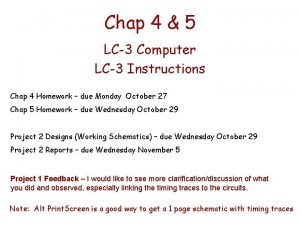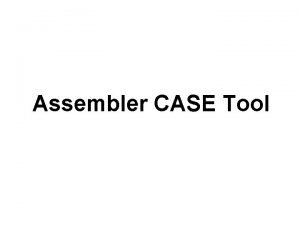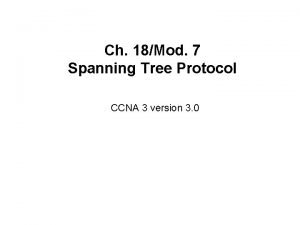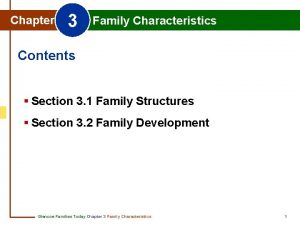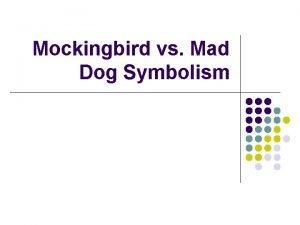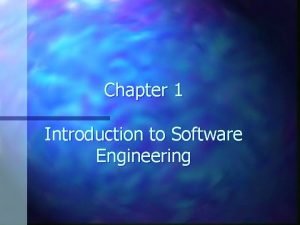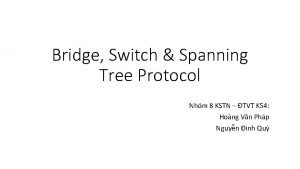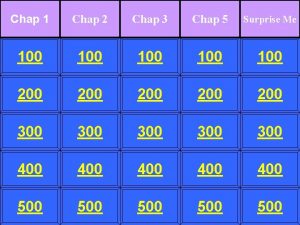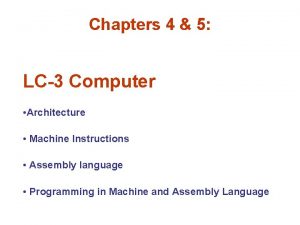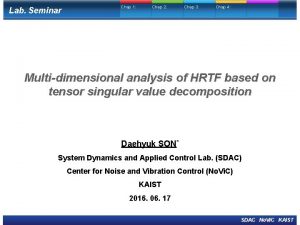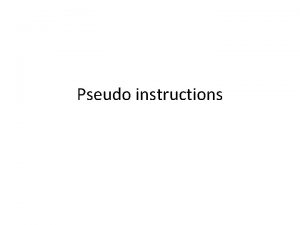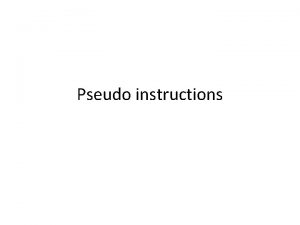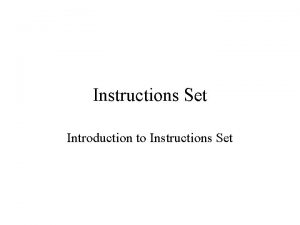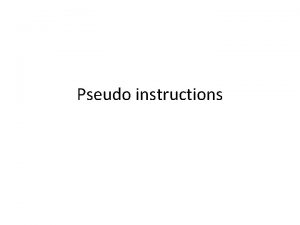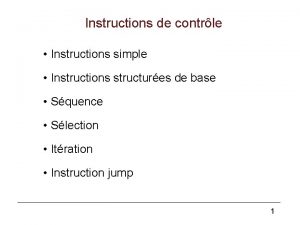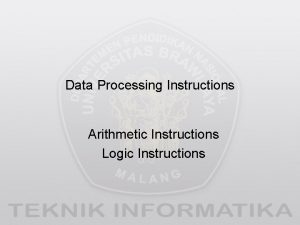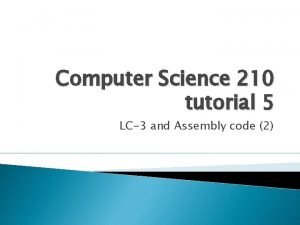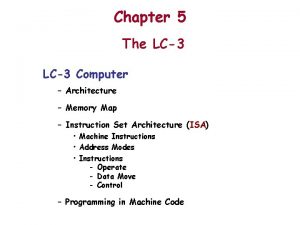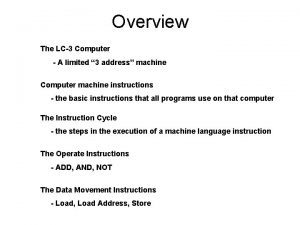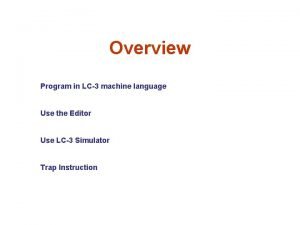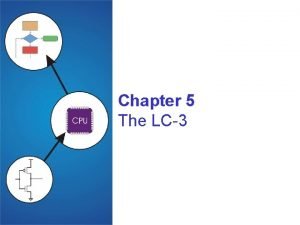Chap 4 5 LC3 Computer LC3 Instructions Chap



















![Branch Instruction BR [0000 nzp PCoffset 9] • Branch specifies one or more condition Branch Instruction BR [0000 nzp PCoffset 9] • Branch specifies one or more condition](https://slidetodoc.com/presentation_image_h/2ea41151b1545b18cbf402c5730d7548/image-20.jpg)

![Jump Instruction JMP Base. R [1100 000 Base. R 000000] • Jump is an Jump Instruction JMP Base. R [1100 000 Base. R 000000] • Jump is an](https://slidetodoc.com/presentation_image_h/2ea41151b1545b18cbf402c5730d7548/image-22.jpg)



- Slides: 25

Chap 4 & 5 LC-3 Computer LC-3 Instructions Chap 4 Homework – due Monday October 27 Chap 5 Homework – due Wednesday October 29 Project 2 Designs (Working Schematics) – due Wednesday October 29 Project 2 Reports – due Wednesday November 5 Project 1 Feedback – I would like to see more clarification/discussion of what you did and observed, especially linking the timing traces to the circuits. Note: Alt Print. Screen is a good way to get a 1 page schematic with timing traces

Chapters 4 & 5: The LC-3 Computer • LC-3 Computer – Architecture – Machine Instructions – Programming in Machine Language (Binary or Hex Code) (One word per instruction) – Programming in Assembly Language (Symbolic Code) (One statement per instruction) • LC-3 Editor & Simulator – Go to: http: //www. mhhe. com/patt 2 – Download: LC-3 Simulator (Either Windows or Unix version) – Simulator Download includes LC-3 (Simulator) & LC-Edit – Download: Simulator Lab Manual

LC-3 Memory Map (64 K of 16 bit words) 256 words 23. 5 K words 39. 5 K words 512 words

The LC-3 Computer a von Neumann machine The Instruction Cycle Fetch: Next Instruction from Memory (PC) (points to) next instruction PC (PC) + 1 Decode: Fetched Instruction Evaluate: Instr & Address (es) (find where the data is) Fetch: Operand (s) (get data as specified) Execute: Operation Store: Result (if specified) PSW Memory PSW (Program Status Word): Bits: 15 | S| 10 9 8 |Priority| 2 1 0 | N| Z| P |

Computer Machine Instruction Formats What is IN an instruction? • Operation code – what to do • Input Operand(s) – where to get input operands (memory, registers) • Output Operand(s) – Where to put results (memory, registers) What are the major instruction types? • Data Movement (load, store, etc. ) • Operate (add, sub, mult, OR, AND, etc. ) • Control (branch, jump to subroutine, etc. )

The LC-3 Instruction Addressing Modes • Register (Operand is in one of the 8 registers) • Immediate (Operand is in the instruction) • PC-relative (Operand is “offset” from the (PC) ) • Indirect (The “Operand” actually points to the real Operand – rather than being the operand) • Base + Offset (Base relative) (Operand is “offset” from the contents of a register) Note: no Direct Addressing defined in the LC-3

LC-3 Instructions (Fig 5. 3 – Appendix a) Addressing Modes • Register (Operand is in one of the 8 registers) • PC-relative (Operand is “offset” from where the PC points) • Base + Offset (Base relative) (Operand is “offset” from the contents of a register) • Immediate (Operand is in the instruction) • Indirect (The “Operand” points to the real address of Operand – rather than being the operand)

Operate Instructions • Only three operate Instructions: ADD, AND, NOT • Source and Destination operands are: Registers

ADD/AND (Register)

NOT (Register) Note: Src and Dst could be the same register.

ADD/AND (Immediate) Note: Immediate field is sign-extended to 16 bits.

Data Movement Instructions • Load - read data from memory to register – LD: – LDI: – LDR: PC-relative mode [0010 DR PCoffset 9] indirect mode [1010 DR PCoffset 9] base+offset mode [0110 DR Base. R offset 6] • Store - write data from register to memory – ST: PC-relative mode [0011 DR PCoffset 9] – STI: indirect mode [1011 DR PCoffset 9] – STR: base+offset mode [0111 DR Base. R offset 6] • Load effective address – address saved in register – LEA: immediate mode [1110 DR PCoffset 9]

LD (PC-Relative)

ST (PC-Relative)

LDI (Indirect)

STI (Indirect)

LDR (Base+Offset)

STR (Base+Offset)

LEA (Immediate)
![Branch Instruction BR 0000 nzp PCoffset 9 Branch specifies one or more condition Branch Instruction BR [0000 nzp PCoffset 9] • Branch specifies one or more condition](https://slidetodoc.com/presentation_image_h/2ea41151b1545b18cbf402c5730d7548/image-20.jpg)
Branch Instruction BR [0000 nzp PCoffset 9] • Branch specifies one or more condition codes Program Status Word (PSW): Bits: 15 | S| 10 9 8 |Priority| 2 1 0 |N|Z|P| • If the set bit is specified, the branch is taken: – PC is set to the address specified in the instruction - Target address is made by adding SEXT(IR[8: 0]) to the PC • If the branch is not taken: - the next sequential instruction (PC) is executed.

BR + SEXT
![Jump Instruction JMP Base R 1100 000 Base R 000000 Jump is an Jump Instruction JMP Base. R [1100 000 Base. R 000000] • Jump is an](https://slidetodoc.com/presentation_image_h/2ea41151b1545b18cbf402c5730d7548/image-22.jpg)
Jump Instruction JMP Base. R [1100 000 Base. R 000000] • Jump is an unconditional branch -- always taken. • Base. R – Address is contents of the register – Allows any target address.

Example LC-3 Program • Write a program to add 12 integers and store the result in a Register.

Compute the Sum of 12 Integers Program • Program begins at location x 3000. • Integers begin at location x 3100. R 1 x 3100 R 3 0 (Sum) R 2 12(count) R 2=0? NO R 4 R 3 R 1 R 2 M[R 1] R 3+R 4 R 1+1 R 2 -1 YES R 1: “Array” index pointer (Begin with location 3100) R 3: Accumulator for the sum of integers R 2: Loop counter (Count down from 12) R 4: Temporary register to store next integer

Sum integers from x 3100 – x 310 B Address Instruction Comments x 3000 1 1 1 0 0 0 1 1 1 1 1 R 1 x 3100 x 3001 0 1 0 1 1 1 0 0 0 R 3 0 x 3002 0 1 0 1 0 1 0 0 0 R 2 0 x 3003 0 0 0 1 0 1 0 1 1 0 0 R 2 12 x 3004 0 0 0 1 0 0 0 0 1 If Z, goto x 300 A x 3005 0 1 1 0 0 0 0 1 0 0 0 Load next value to R 4 x 3006 0 0 0 1 1 0 0 0 1 0 0 x 3007 0 0 0 1 1 0 0 1 Increment R 1 (pointer) X 3008 0 0 0 1 0 1 1 1 1 Decrement R 2 (counter) x 3009 0 0 1 1 1 1 1 0 Goto x 3004 Add to R 3 R 1: “Array” index pointer (Begin with location 3100) R 3: Accumulator for the sum of integers R 2: Loop counter (Count down from 12) R 4: Temporary register to store next integer
 Chap chap slide
Chap chap slide Str lc3
Str lc3 Pseudo instructions mips
Pseudo instructions mips Basic computer instructions
Basic computer instructions Where a computer keeps data, instructions, and information
Where a computer keeps data, instructions, and information Instructions language of the computer
Instructions language of the computer Little man computer mnemonics
Little man computer mnemonics The banking industry almost exclusively uses
The banking industry almost exclusively uses 패션 chap 1
패션 chap 1 Passion chap 6
Passion chap 6 Bank run chap 11
Bank run chap 11 Durbin chap
Durbin chap Cardamom riddles
Cardamom riddles Kstn chap 18
Kstn chap 18 Family control ch3
Family control ch3 Origin of species manhwa chapter 24
Origin of species manhwa chapter 24 Needs/wants that has been satisfied
Needs/wants that has been satisfied Origin of species manga chapter 22
Origin of species manga chapter 22 What does the mad dog symbolize in to kill a mockingbird
What does the mad dog symbolize in to kill a mockingbird Matthew chapter 5
Matthew chapter 5 Kinds in development chap 1
Kinds in development chap 1 Rivalry 1 chapter 6
Rivalry 1 chapter 6 System engineer chap 1
System engineer chap 1 Chap tree
Chap tree Kstn chap 7
Kstn chap 7 I was in that state when a chap easily turns nasty analysis
I was in that state when a chap easily turns nasty analysis

